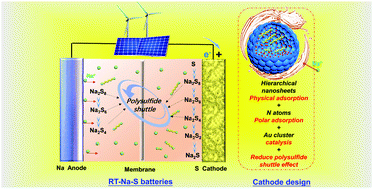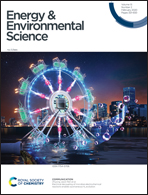High-performance room-temperature sodium–sulfur battery enabled by electrocatalytic sodium polysulfides full conversion†
Abstract
Room-temperature sodium–sulfur (RT-Na–S) batteries are highly desirable for grid-scale stationary energy storage due to their low cost; however, short cycling stability caused by the incomplete conversion of sodium polysulfides is a major issue for their application. Herein, we introduce an effective sulfiphilic host, gold nanodots decorated on hierarchical N-doped carbon microspheres (CN/Au/S), to achieve completely reversible conversion reactions in the S cathode by electrocatalyzing the low-kinetics conversion of Na2S4 into NaS2 (discharge process) or S (charge process). Besides, gold nanodots and N-doped carbon can increase the conductivity of the S cathode and provide strong polar–polar adsorption of sodium polysulfides to alleviate the shuttling effects. When serving as the cathode, the CN/Au/S composite can realize enhanced sulfur utilization, excellent cycling stability, and outstanding rate capability. This work deepens our understanding of the catalytic effect of gold atoms on sulfur molecules, opening a new avenue for cathode design and development of advanced RT-Na–S batteries.

- This article is part of the themed collection: Battery science and technology – powered by chemistry


 Please wait while we load your content...
Please wait while we load your content...